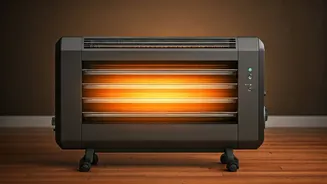Efficient Heating Options
The quest for the ideal room heater involves balancing immediate warmth with long-term energy savings. Different heater types cater to various needs and
preferences. For instance, radiant heaters excel at rapidly warming up specific areas, while convection heaters circulate warm air throughout a room. Oil-filled heaters provide consistent warmth over extended periods, and ceramic heaters often combine rapid heating with energy efficiency. Understanding these different types is the initial step toward making an informed choice, evaluating aspects like room size, insulation, and individual comfort requirements. The goal is to choose a heater that delivers optimal warmth without a significant impact on electricity bills, offering a balance between comfort and cost-effectiveness.
Ceramic Heater Advantages
Ceramic heaters frequently stand out for their quick heating capabilities combined with energy-efficient operation. These heaters utilize ceramic plates that rapidly heat up when electricity passes through them, and then transfer this heat to the surrounding air. Many ceramic models include adjustable thermostats and safety features such as automatic shut-off to prevent overheating, further enhancing their appeal. These features contribute to both user convenience and safety. These heaters are often designed with a compact footprint, making them suitable for use in various rooms, including bedrooms, offices, and small living areas. When choosing a ceramic heater, consider factors like the wattage (which impacts heating speed) and additional features such as oscillation, which spreads heat more evenly throughout the room.
Oil-Filled Radiator Heaters
Oil-filled radiator heaters offer a different approach, providing consistent, gentle warmth over extended periods. These heaters don’t heat the air directly; instead, they warm the oil inside their sealed units. The oil then radiates heat outwards, warming the room slowly and steadily. Unlike some other heater types, they don't dry out the air, creating a more comfortable indoor climate. This is particularly advantageous for individuals who are sensitive to dry air. However, they may take slightly longer to heat a room compared to other types. These heaters are frequently equipped with adjustable thermostats and safety features. This kind of heater is often a great choice for bedrooms or living rooms where a consistent temperature is desired throughout the night or for long periods.
Convection Heater Benefits
Convection heaters are designed to warm rooms by circulating air. They heat the air, which then rises, creating a convection current that distributes warmth across the space. These heaters can be highly effective in warming entire rooms, making them suitable for larger areas. Many convection models include adjustable thermostats and fan-assisted heating to improve the speed of heating. While they may take slightly longer to warm a space than radiant heaters, they provide a more evenly distributed heat. Convection heaters can also be a good option for people who prefer a consistent warmth rather than direct heat. They are often a good option for family rooms or offices.
Radiant Heater Spot Heating
Radiant heaters are ideal for spot heating, providing immediate warmth in a specific area. These heaters use infrared technology to directly warm objects and people within their range, rather than heating the air. They are particularly suitable for small areas or when instant warmth is needed. Radiant heaters are often energy-efficient since they focus their heat, avoiding the need to heat an entire room. They are often used in bathrooms or small workspaces where quick and targeted heating is preferred. Radiant heaters can be a good choice for those who want instant warmth and don't need to heat a whole room. Some models come with adjustable settings and safety features, adding to their overall appeal.
Energy-Saving Features
When selecting a room heater, various energy-saving features can contribute to lower electricity bills. Adjustable thermostats are essential, allowing users to control the desired temperature and prevent overheating. Programmable timers enable the heater to switch on and off automatically, conserving energy when the room is not in use. Many modern heaters include an 'eco' mode that optimizes energy consumption by automatically adjusting the heat output to maintain a comfortable temperature. Automatic shut-off features are a crucial safety element and also prevent energy waste when the heater is left unattended. Considering heaters with these features ensures both cost savings and peace of mind when it comes to energy use.
Safety Considerations
Safety should be a primary concern when using any room heater. Always ensure the heater is placed on a stable, level surface and away from flammable materials such as curtains or paper. Heaters should never be left unattended, especially when children or pets are present. Many heaters come with built-in safety features like tip-over protection, which automatically shuts the heater off if it is knocked over. Overheat protection is another important safety element, preventing the heater from exceeding a safe temperature. Inspect the power cord regularly for damage, and if any damage is found, do not use the heater. Following these safety guidelines ensures a secure and comfortable heating experience.
Choosing the Right Wattage
The wattage of a room heater impacts its heating capacity and energy consumption. Generally, a higher wattage means a quicker heating speed, but it will also consume more power. The optimal wattage depends on the room size: smaller rooms require less wattage than larger spaces. As a rule of thumb, you might aim for 10 watts per square foot of room area, but this can vary depending on insulation and other factors. It's often beneficial to choose a heater with adjustable power settings. This provides flexibility: you can use a lower setting for energy-saving when a room is already warm, and a higher setting for quick heating when needed. When choosing, consider both the initial heating needs and long-term operating costs.
Maintenance and Care
Regular maintenance extends the lifespan of a room heater and ensures safe operation. Dust and debris can build up on the heating elements and internal components, reducing efficiency and possibly creating fire hazards. It's essential to clean the heater regularly, following the manufacturer's instructions. Usually, this involves using a vacuum cleaner or a soft brush to remove dust and dirt. For oil-filled heaters, check the oil levels periodically (if applicable). Never immerse the heater in water or use harsh chemicals for cleaning. Store the heater in a dry, protected place when it is not in use, and check the power cord and other parts before each season. Proper care will ensure your heater's optimal performance and your safety.
Top 10 Picks Recap
The selection of the 'top 10' room heaters will likely involve a variety of types, encompassing both radiant, convection, ceramic, and oil-filled models. Criteria include heating speed, energy efficiency, safety features, and user reviews. You'll find options for various room sizes and requirements, from compact ceramic heaters for small spaces to powerful convection heaters for larger rooms. The list will likely include heaters with programmable thermostats, timers, and eco-modes to promote energy conservation. Each selection will be assessed based on its specific strengths, considering factors like heating time, ease of use, safety certifications, and overall value. The aim is to provide a comprehensive guide, ensuring the selection is ideal for your needs.















